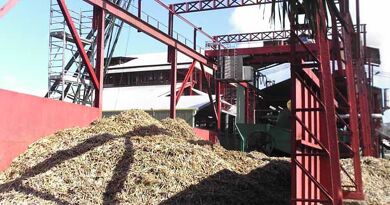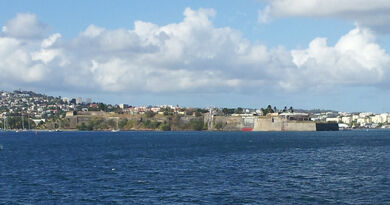The West Indian house
The West Indian house
A thick cover of leaves made the stay more pleasant than that of the thatched cottages of France, according to the old chroniclers. At the end of the century, Fr. Labat pointed out the ideal material for this kind of construction: the palm tree, whose trunk burnt only at the end which is driven into the ground, provides the posts; split in two, it still provides sand pits, soil, ridge tiles and rafters; split into eight or ten parts, it gives slats where you can cut the ankles that fix them; the leaves linked together by their braided leaflets are the most resistant vegetable tiles since they can hold the roof for 8 to 10 years. The hut usually included three rooms, a room, a room and a pantry, the latter of European tradition, disappeared later. (noted Bertrand: the same arrangement is observed in the Caribbean boxes described by R. P. Du Tertre).
Its roof was low in order to offer less hold to gusts of wind, it appeared clean, sometimes flirtatious, and its lightness, the assembly of the partitions by means of dowels offered the advantage of moving it as easily raw furniture as it housed. “
(The Landbreakers and the small settlers of Martinique in the 17th century).
The house is installed on an elevation allowing easy surveillance of the area, as well as ventilation and drying of the house. Especially in this 17th century we are on two islands full of swamps and mosquitoes, carrying fevers and malaria. With the development of the concession, the area is enriched with new operating facilities, “the menagerie” which includes: the cassava box or “gragerie”, the petun box, the indigoterie, the homes of the bullfighters, commanders and slaves, the latter being in very small numbers among the little settler. Where there will be no cultivation of sugar cane, there will be practically no slaves, as is the case with Saint-Barthélémy Island.
THE RURAL HOUSE
Always in wood, because in the islands (and until today) it is the healthiest material, the classic plan of the rural house includes the house, the kitchen, the stable and the hutch, all placed on a natural terrace and openings oriented towards the trade winds. The outbuildings (kitchen, stable, hutch) are located downwind of the main house.
Inhabited by the country people, whose life is divided between the seasonal work of the cane and their tiny “vegetable garden”, this hut is located completely independent of the communication paths. The hut has two rooms, one of which is completely blind and serves as a bedroom, while the other, with three openings (one window and two doors) will be the dining room and guest room. Extensible at low cost, because we can add new pieces according to the needs of the family, we sometimes add a gallery, where the family and especially young children spend their time there, especially in the rainy season.
The very inclined roof is like a gallery, a sign of prosperity when you manage to change the sheet metal with tiles. This hut was very often built until around the 1960s in gaulettes, and covered with cane straw.
For several years, mass constructions on land subdivided by the municipalities have replaced these huts with more modern, “hard” houses that are fairly well designed, although their rooms are small. But there is reason to especially regret the absence of space among these country folk, whose “vegetable gardens” were an addition to their income, as also the possibility of small livestock. Because in the Tropics, the house is a shelter while most of everyday life is spent outside. Note that the West Indies do not have farms, because these islands do not have a real peasantry but more or less comfortable agricultural workers.
The rural house, among the wealthy, will always be made of wood, but covered with tiles, with gallery, and shutters on the windows. It has an entrance-living room, two bedrooms, a dining room and outbuildings, these always separated from the main house.
It is the style of this type of house that will be used for holiday homes on the properties of the city dwellers of the islands, and where we will find very pretty gardens of flowers and tropical trees as well as magnificent colonial style furniture.
HOUSING
In addition to the gallery house, it is the house-dwelling which has brought together the qualities of comfort and style specific to the Tropics. It is a masonry house, located on a hill and designed according to a plan, always the same: a rectangular building flanked by two galleries, one of which is generally covered. The tiled roof slopes gently. The attic serves as a habitable floor. The rooms are spacious, high ceilings, and where colonial style furniture, in solid wood and very beautiful, find their place there and give an impression of quiet and patriarchal life.
Perfectly oriented, these dwellings are ton-cool and R. P. Delawarde notes in his essay on human geography that:
the spirit of these residences, analogous to that of Spanish constructions in America, proceed from this decision of the first colonists to remain and to make stock on the spot. We had not adopted a colonial style then, we built small houses, without galleries, quite often on one floor, with an external staircase, like those of the French provinces where we came from. But we made them to last. Their strong walls will long defy bad weather and even cataclysms. They were built to withstand cyclones and earthquakes,? what can not be said absolutely about modern houses,? with abundant rubble carried by slaves and drowned in an empirical mortar in which entered ashes, cane syrup, madreporic lime or made of shells, as evidenced by the fragments found there. The walls rise thick, with well cut corner stones. The device, of medium size, offers the dark color and the rough touch of andesic stones, much more numerous with the dacistes sometimes detached in sheets.
… However, it sometimes happens that the impression of robustness that these stocky constructions give is ill-founded because, demolishing certain very thick walls and widened at their base, there is, between two suitably made facings, a loose mortar dominating the oily earth or ash; we had run out of lime. The openings of the old houses are mediocre, the bays, sometimes arched, have a frame of cut stones, the interior is a little dark but still fresh. An 18th century vintage sometimes brings certainty. ”
(Peasant life in Martinique).
The house will be not only a type of house, but a real agricultural unit, led by an owner with a servile workforce and whose products are industrialized in a traditional way and intended for export. It will be the basis of the colonization of the islands and the prosperity of these dwellings will depend on the whole life and organization of the islands.
Like the pioneers’ concession, which remains the prototype, housing includes:
a) the main building, used as accommodation,
b) production buildings: distillery, indigotery, cassava grating, petun sheds, beef mills, etc.
c) the staff accommodation buildings: bullfighters, commanders and “the case-negro street” or the slave huts.
Very often the house will resemble an easy house in the French countryside; but the house-fortress type will predominate, whose doors? and casement windows in solid and hard wood, completely close the building. A wall of stones and masonry surrounds it.
THE MODERN HOUSE
There is no modern tropical house, the style of current architecture having penetrated the islands. The increase in the Antillean population forces a policy of building blocks, which does not seem to have been found a solution adapted to the Tropics. Noise, heat, lack of space in sunny countries are general disadvantages. The system of construction credit applies in the hot climate the standards of houses with cold climate which results in rooms of 3/3 m., Lack of terraces and small openings. Ventilation remains the main requirement, which, as a consequence, requires the study of openings. This is to ensure openings designed so as not to communicate the noise of neighbors (radio, television, children and babies). At the Universal Exhibition in Montreal, a type of housing was exhibited which could be a clear improvement in mass production and at low cost. This involves placing the apartments in the same way as the layers of a hill, the roof of an apartment serving as a garden and terrace as that of the upper floor. In addition to the needs of specific comfort, the town planners and the architects who build in these islands have vast problems to solve like the leveling of the old districts, water supply, drying and firming of the grounds, etc … The city de Pointe à Pitre has been carrying out the largest urbanization and mass housing program in the French Antilles for several years and constitutes an excellent field of experience. Starting from the files of this city, it appears certain that an improvement can be achieved both in style and in the standards of financing a specifically tropical housing, and will allow to erect in Guadeloupe and Martinique such a pleasant habitat. than that of the past.
It is also necessary to take into account the research and achievements of housing for hot climate in Brazil and Mexico, hoping that the public as the architects can be informed and, if necessary, go there for study.
Anca BERTRAND.




